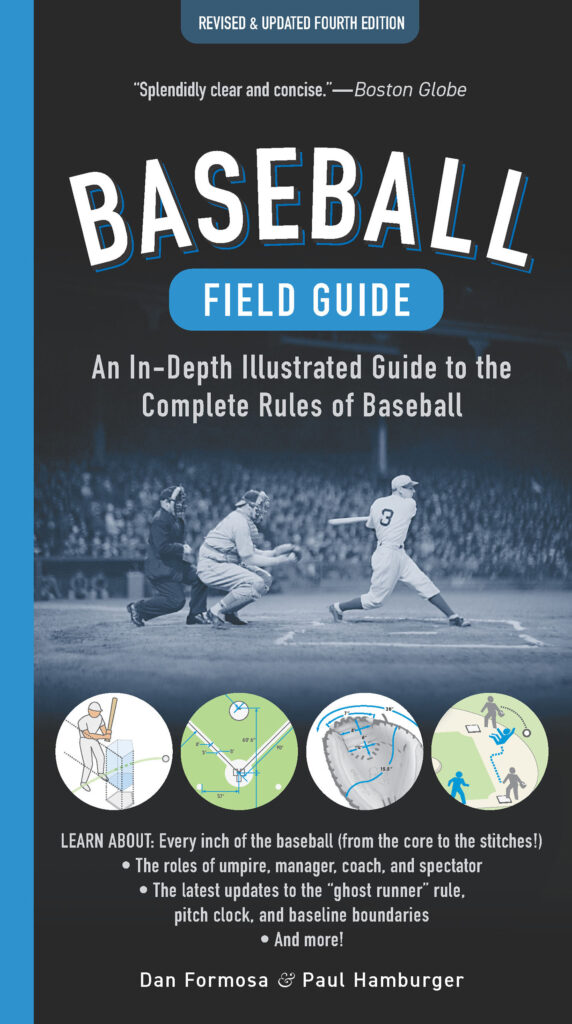The best way ever to understand
the complete rules of Major League Baseball!
Our new, expanded 4th edition explains
• Defensive shifts
• Bigger bases
• The pitch clock
• And of course the infamous Infield Fly Rule.
There are so many recent rule updates that we added 16 new pages.
Includes rules you need to know about:
Defensive shifts
The new rule on defensive shifts requires the first and second basemen to be on the right of second base, and the shortstop and third baseman to be on the left at the time of the pitch. There’s no more moving to one side or the other based on where a batter tends to hit.
Bigger bases
Bases are bigger. Previously 15 inches square, the new bases are 18 inches square. This reduces the distance between first and second bases and the distance between second and third by 4.5 inches. While that may not seem like a lot, it promises to keep a lot more runners safe on base.
The pitch clock
Several rules have been put in place to reduce the dominance of pitchers, who have been getting significantly better at reducing hits over the years. One new rule requires the pitcher to deliver his pitch within 15 seconds when no one is on base or 20 seconds when one or more runners are on base.
Crackdown on the sticky stuff
Umpires are being a lot more careful about ensuring that pitchers aren’t applying sticky substances like Spider Tack to their hands or the ball, as their use has been a growing trend in recent years.
Whether you're new to the game or a seasoned fan
We wrote and designed this guide for everyone—novice to expert, young and old. While the official rules of baseball contain all the information you might need, they aren’t easy to read. Searching through them is like reading a legal document, and nothing is explained very well. Our book solves those issues.
Baseball is a lot more fun when you know the rules
While some rules are very well-known, many are obscure. Understanding the rules keeps you ahead of the game, your know-it-all friends, and sometimes even the umpires.
Your helpful field guide
We designed this book as a field guide that lets you quickly look up a rule as the game is taking place. While you may choose to read it cover to cover, it’s also a great book to have at your side as you’re at the stadium—or to pick up once in a while to brush up on some rules.

MLBs most significant rule changes in decades
Major League Baseball has been under pressure to maintain and increase viewership, which has caused them to implement a bevy of new rules. Their goal is to add more action while shortening the time taken to play the game. It’s the 2020s, and apparently we’re all in a hurry—while the game has drifted over the decades. Batting averages are down, while game times have been getting longer. For fans, it’s not the same game it was in the 1950s—but with these new rules, it could become even better.
16 added pages
So many recent rule changes have been implemented that we added 16 new pages, along with new illustrations.
Faster and better games
Pay attention and you’ll readily notice some new rules in place. Some are easy to notice: For example, pitchers now have a limited time to pitch. Bases are bigger, which is an advantage for runners. Infielders must stay in place—for the first time ever, the rules are telling them where to stand. All these rule changes and more lie within.
All of Major League Baseball's rules clearly explained.
Touched by a batted ball
What takes place after a runner is hit by a batted ball is dependent on a number of factors – such as the position of the fielders.
Equipment specifications
Each baseball needs to meet very specific requirements that affect its flight. Specifications for gloves, uniforms, and bats are also clearly explained.
The set and windup positions
A pitcher will use one of two legal pitching positions: the windup position and the set position. Either can be used at any time in a game. They look different.
Statistics made simple
Some baseball statistics can be quite complex: For example, on-base percentage (OBP) is tricky. We break down the numbers to clearly explain where each statistic comes from.







